Heating a private house with solar panels: diagrams and device
The reasons for the popularity of alternative energy sources are quite understandable: there is an opportunity to save on fuel and make dreams of environmentally friendly life support systems come true. By skillfully using the energy of the sun, wind and water, you can turn an ordinary country house into a modern eco-house.
We will tell you how to install solar heating in a private home, and we will analyze with you how profitable it is. In order to thoroughly cover the issues of using daylight energy, we have described in detail all the popular options that have received practical application and positive user reviews.
Taking into account our recommendations, you can build an effective solar system for a summer house or country house. To make the difficult material easier to understand, we have supplemented the information with visual diagrams, illustrations and video tutorials.
The content of the article:
Ways to use solar energy
Methods of application energy of the celestial body do not belong to innovative technologies; solar heat has been used for a long time and very successfully. However, this applies mainly to Australia, some countries in Europe, America and the southern regions, where alternative energy can be obtained throughout the year.
Some northern regions lack natural radiation, so it is used as an additional or backup option.
The intermediaries between the sun's rays and the energy-generating mechanism are solar panels or collectors, which differ in both purpose and design.
Batteries accumulate solar energy and allow it to be used to power household electrical appliances. They are panels with photocells on one side and a locking mechanism on the other. You can experiment and assemble the battery yourself, but it’s easier to buy ready-made elements - the choice is quite wide.
Solar systems (solar collectors) are part of the heating system of a house. Large thermally insulated boxes with coolant, like batteries, are mounted on raised panels facing the sun or roof slopes.
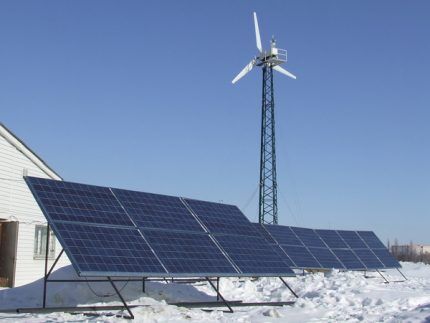
To increase efficiency, the panels are placed on dynamic mechanisms reminiscent of a tracking system - they rotate following the movement of the sun. The energy conversion process occurs in tubes located inside the boxes.
The main difference between solar systems and solar panels is that the former heat the coolant, and the latter accumulate electricity. It is possible to heat the room using photocells, but the design schemes are irrational and are suitable only for those areas where there are at least 200 sunny days a year.

Pros and cons of an alternative heating system
There are not many advantages of a solar heating system, but each of them is significant and can become a reason for private experiments:
- Environmental benefits. This is a clean source of heat that is safe for the residents of the house and the surrounding environment and does not require the use of traditional types of fuel.
- Autonomy. System owners are absolutely independent of energy prices and the economic situation in the country.
- Economical. By maintaining the traditional heating system, it becomes possible to reduce the cost of paying for hot water supply.
- Public availability. To install solar systems, you do not need permission from government authorities.
But there are also unpleasant moments that can spoil the overall picture. For example, determining the efficiency of the system will require a long period - at least 3 years (provided that there is enough solar energy and it is used actively).
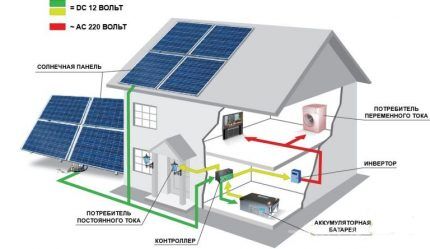
Users note the following disadvantages:
- high prices for equipment necessary to put the system into operation;
- direct dependence of the amount of heat produced on geographic location and weather;
- the mandatory presence of a backup source, for example, a gas boiler (in practice, a solar system is often a backup).
To achieve greater returns, you have to regularly monitor the serviceability of the collectors, clean them of debris and protect them from the formation of ice during frosts. If the temperature often drops below 0ºC, you need to take care of additional thermal insulation not only of the elements of the solar system, but also of the house as a whole.
Solar energy for heating
The main purpose of energy storage photovoltaic cells is to provide electricity to the home. To include them in the diagram heating system devices and to achieve optimal functioning, it is necessary to assemble the circuit with a storage tank.
It is in it that the water will be heated, which, having reached a certain temperature, will fill the pipes and radiators in the rooms that require heating (living room, bathroom).
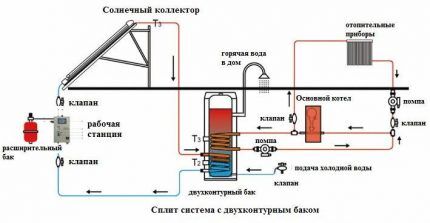
Let's try to analyze the design features of solar panels and determine their potential role in the heating system.
The principle of operation of panels with photocells
There are three common types of elements for solar panels:
- Monocrystalline. These are thin wafers of the purest silicon, cut from a crystal grown under artificial conditions. The most productive variety with an efficiency of about 17-18%. The optimal temperature for operation is from 5 ºС to 25 ºС.
- Polycrystalline. Made from wafers obtained by gradual cooling of silicon melt. The technology for their production is less labor-intensive, but the efficiency of photovoltaic elements made from polycrystalline is significantly lower - no more than 12%.
- Amorphous. They are film. Manufactured by the evaporation phase method, as a result of which silicon in the form of a thin film is deposited on a flexible polymer base. The cheapest production method is combined with low productivity, estimated at up to 7%.
For the installation of autonomous heating systems in the northern regions, the most suitable option is considered photovoltaic batteries, assembled from monocrystalline elements. However, batteries with amorphous modules are easier to install, practically do not require a base and are much cheaper.
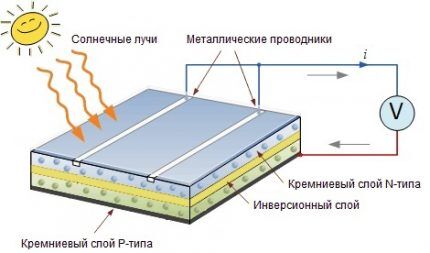
The task of external elements is to absorb and transform the sun's rays. The released energy goes further and is concentrated in the storage tank. A small element produces about 100-250 W, and a prefabricated panel of 25-30 m² provides electricity to a small house. Installing a heating system will require 2-3 times more energy.
An inverter acts as a converter of direct current from solar “production” into electricity, since alternating current is required for the operation of household electrical appliances and lamps.
If we talk specifically about the heating system, an electric boiler for heating water also runs on alternating current. To provide light to your home at night, you will need batteries that store daytime supplies.
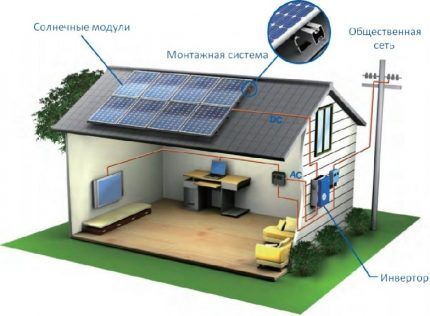
Efficiency of using photocells
Easiest to purchase solar collectors and apply one of the simple schemes that have been proven over the years. However, circumstances sometimes dictate their own conditions. Let's say you have a great functioning solar generator system, but for now it only serves to supply electricity and provide hot water to your home.
It is clear that buying new equipment is unprofitable, so it is easier to increase power by purchasing a certain number of photoelectric converters. Budget option - silicon panels with productivity up to 23-25%.
It is necessary to connect a heating device that runs on electricity to the current source.A universal option is a boiler equipped with distribution wiring.

If the electricity supply is properly organized, it should be enough for both hot water supply and heating. There are examples when the house is fully provided with heat - it can be recognized by the roof, almost completely covered with panels.
Sometimes it is necessary to erect special free-standing structures if the roof area is not enough. It turns out that to increase power, additional free space is needed.
Even the most careful calculations will not help you determine the exact amount of potential energy and quickly create an effective, well-functioning system. The fact is that in practice obstacles arise, the appearance of which is quite difficult to predict.
Here are some of the factors:
- Inconsistency of weather. The exact number of sunny days is unknown even in the southern regions. It is almost impossible to reliably predict their number in the northern regions.
- Irregularity of receiving electricity. For example, in the northern regions there are short daylight hours in winter, so a lot of recycled solar energy is spent on lighting. In addition, the intensity of solar radiation in winter decreases significantly.
- Periodic breakdowns. Like all technical systems, solar panels can fail from time to time due to damage to individual elements, contract connections, protective surfaces, etc.
Consequently, you can find out about the effectiveness only after a certain period of time, at least after a year. It may be necessary to increase the number of photocells or batteries, consider additional thermal insulation of the house, and reduce the heated area. Suppose that in the northern regions of Germany, in order to save money, bedrooms are often not heated at all.
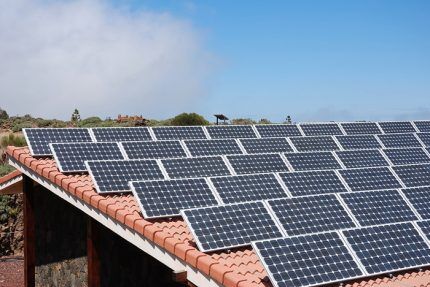
Home power plant installation diagram
The easiest way solar generator installations – contacting a company that sells system components and offers installation services. Pros - a professional project taking into account individual characteristics, a guarantee for all products and installation, minus - high cost.
If you have relevant experience, you can independently assemble a mini-power station with solar panels for heating a private home.
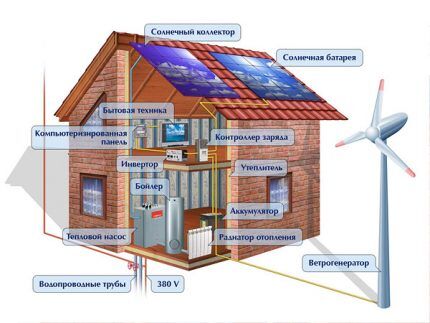
All parts for assembling the heating system are sold in specialized stores.
You must purchase the following components:
- a set of silicon or film solar modules;
- a rechargeable battery that stores energy;
- charge controller that regulates the process of charging and discharging the battery;
- an inverter that converts direct current into alternating current;
- set of connecting cables.
It is desirable that the batteries be the same (taking into account the brand, capacity and even batch) and be able to store energy for 3-4 days. The duration of their operation depends on the room temperature - in cold conditions they quickly discharge. If the daily consumption is 2400 Wh, batteries with a total capacity of at least 1000 Ah are required.
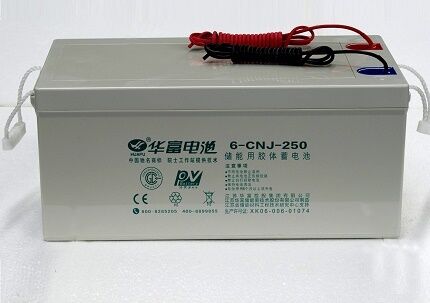
The quality of the current produced by sinusoidal inverters for solar systems, higher than the current indicators from the centralized network. A special feature of the equipment is the synchronization of the voltage phase, in which the transition from 12 V to 220 V is carried out without interruption in the functioning of household electrical appliances.
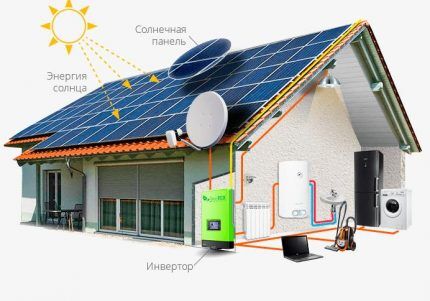
After installing all the elements of the solar system, it is necessary to connect an electric tank that heats the water to the inverter, and to the tank, in turn, a heating pipeline.
Collector heating system
The greatest efficiency and return can be achieved by installing collectors instead of solar modules - external installations in which water is heated under the influence of solar radiation. Such a system is more logical and natural, since it does not require heating of the coolant by other devices.
Let's consider the design and principle of operation of two main types of devices: flat and tubular.
Flat version for self-production
The design of flat installations is so simple that experienced craftsmen assemble handicraft analogues with their own hands, purchasing some of the parts in a specialized store, and constructing some from scrap materials.
Inside the steel or aluminum insulated box there is a plate that absorbs solar heat. Most often it is coated with a layer of black chrome. The heat absorber is protected on top by a sealed transparent cover.
The water is heated in tubes arranged like a snake and connected to the plate. Water or antifreeze enters the box through the inlet pipe, heats up in the tubes and moves to the outlet - to the outlet pipe.

There are two types of connection, one-pipe and two-pipe; there is no fundamental difference in the choice. But there is a big difference in the way the coolant will be supplied to the collectors - gravity or using a pump. The first option is considered ineffective due to the low speed of water movement; according to the heating principle, it resembles a container for a summer shower.
The functioning of the second option occurs due to the connection of a circulation pump, which forcibly supplies coolant. The energy source for operating the pumping equipment can be a solar-powered power system.
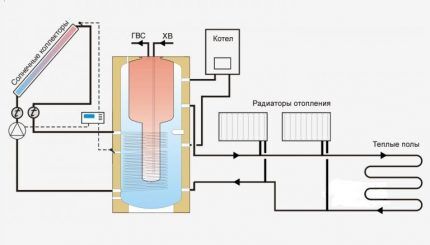
Tubular collectors - a solution for the northern regions
The general principle of operation is reminiscent of the functioning of flat analogues, but with one difference - heat exchange tubes with coolant are located inside glass flasks. The tubes themselves can be feather, sealed on one side and resembling feathers in appearance, and coaxial (vacuum), inserted into each other and sealed on both sides.
Heat exchangers are also different:
- system for converting solar energy into thermal energy Heat-pipe;
- a regular U-type coolant transfer tube.
The second type of heat exchanger is considered more efficient, but is not popular enough due to the cost of repairs: if one tube fails, the entire section will have to be replaced.
The Heat-pipe is not part of an entire segment, so it can be changed in 2-3 minutes. Failed coaxial elements can be repaired by simply removing the plug and replacing the damaged channel.
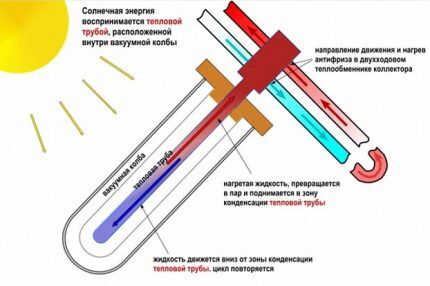
After analyzing the technical characteristics of various types of collectors and summarizing the experience of their use, we decided that flat-plate collectors are more suitable for the southern regions, and tubular ones are more suitable for the northern regions. Installations with the Heat-pipe system have proven themselves especially well in harsh climates.They have heating ability even on cloudy days and at night, “feeding” on a minimal amount of sunlight.

Method for increasing productivity
Usually, after experimenting with a small number of solar modules, private home owners go further and improve the system in various ways.
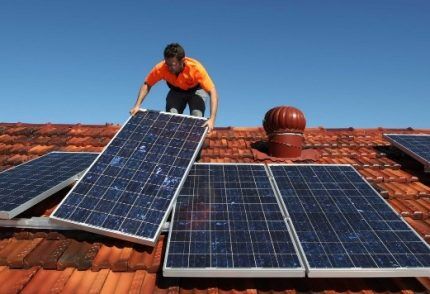
What to do if there is a shortage of free space? Here are some recommendations for increasing the efficiency of a solar station (with photocells or collectors):
- Changing the orientation of modules. Moving elements relative to the position of the sun. Simply put, installing the bulk of the panels on the south side. During long daylight hours, it is also optimal to use surfaces facing east and west.
- Tilt angle adjustment. The manufacturer usually indicates which angle is most preferable (for example, 45º), but sometimes during installation it is necessary to make adjustments taking into account geographic latitude.
- Correct choice of installation location. The roof is suitable because it is most often the highest plane and is not obscured by other objects (for example, garden trees). But there are even more suitable areas - rotating sun tracking devices.
When the elements are positioned perpendicular to the rays of the sun, the system works more efficiently, but on a stable surface (for example, a roof) this is only possible for a short period of time. To increase this, practical tracking devices have been invented.

The big disadvantage of tracking devices is their high cost. In some cases, it does not pay off, so there is no point in investing in useless mechanisms.
It is estimated that 8 panels is the minimum number at which the costs will be justified over time. You can use 3-4 modules, but under one condition: if they are directly connected to the water pump, bypassing the batteries.
Just the other day, Tesla Motors announced the creation of a new type of roof - with integrated solar panels. Elon Musk said that the modified roof will be cheaper than a conventional roof with collectors or modules installed on it.
Conclusions and useful video on the topic
Thematic videos will help you better imagine the design of home solar stations and will reveal some of the secrets of installing equipment.
Video #1. Available technical information about solar panels and charge controllers:
Video #2. Useful experience of using solar panels in the Moscow region:
Video #3. An example of a successfully operating solar station, completely assembled independently, providing both hot water supply and heating of the house:
As you can see, a solar heating system is a very real phenomenon that you can implement yourself. The field of alternative methods of obtaining energy is constantly developing, perhaps tomorrow you will hear about a new discovery.
We invite you to actively comment on the material. You can express your attitude towards “green energy”, share your experience in installing a system of solar panels, and tell only you the known subtleties in the block located below.




I recently had the idea of how to make my home energy independent. In modern realities, electricity prices are rising, and a solar electricity system in this vein can be an excellent solution. In the future, when technology develops, I want to make an energy-independent house, because the more technology develops, the cheaper its cost. In the meantime, let’s follow the news in the development of solar cell technology :)
Having personal experience in operating solar panels, I can express my opinion, confirmed by practice. For the climatic conditions of central Russia, the use of such devices is in no way justified. Solar panels work normally only from April to the end of September. At this time they are most efficient, producing from 70 to 95% of the energy. And when heating is really needed - this is in the period November-March, they produce from 10 to 50% of the declared power. Solar panels are more suitable for heating water in summer (in our climatic conditions).
So far I only have a mini-station on the balcony. 100W panel.Now it doesn’t give much, it’s enough to service lamps and a working computer; in the summer, the range, so to speak, expands somewhat, but still not enough. The thing itself is interesting, but you need to take into account weather conditions, the specifics of energy consumption, and a bunch of other things. To actually use it, you need to invest a lot.
What about the impact on a person? Do solar panels generate any harmful fields there?
Olesya, the panels do not create any radiation, they only absorb it. From this point of view, there is absolutely nothing to worry about.
Guys, are there solar systems that send voltage back to the city grid if you do not use the extracted solar energy in household appliances? They say the meter can go back...
I understand the essence of your question, but in order to transfer the remaining unused energy to the city power grid, special solar panels are not needed. To do this, you must have a special inverter that will be connected to the city power grid; it will redirect excess energy.
From the technical side, everything is quite simple, such a connection is possible, which cannot be said about the legislative component. For example, in Russia, feeding into the network is prohibited, there is simply no “green tariff”, the legislative draft has been under consideration for more than five years.
In Ukraine, for example, prices on the “green tariff” are now lower than sales prices, so it has become more profitable to use the surplus than to sell it to the network.In such cases, you simply limit production when the inverter power is set only to current consumption.
Dear expert, you are very mistaken about the “green tariff” in Ukraine. The cost of selling surplus to the network is 10 times higher than the cost of electricity on the network!! So power plants under the “green tariff” are now the fastest-paying activity!
I saw a TV show about Germany. There, a German in a private house has such a system. He is paying off part of the loan he took out to purchase a solar system.
When will electro-thermal batteries be created?
The 15kW well pump is now powered from the mains. I want to create solar energy without batteries. Can?
And if you install a 30 kW solar station, put electric batteries, an electric boiler and storage batteries in the house, will it be enough in winter? Location central Ukraine